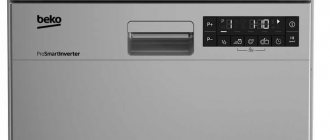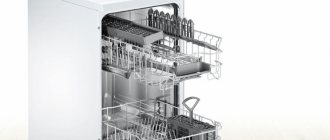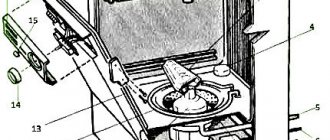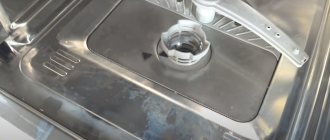The question of whether a dishwasher is needed is often heard today, regardless of how many people live in the house/apartment. Such a unit is used along with other household appliances; it has become a familiar attribute of the kitchen, so it is sometimes included in the design project of the room by default, like a microwave oven or a kettle. However, there is not always free space in the room, so you need to determine for yourself the feasibility of such a purchase.
Why do you need a dishwasher?
The main purpose of using such technology is to make life easier and provide the opportunity to do personal business instead of washing dishes. People are developing new units to save time and effort. As a result, the number of equipment increases, and it is often difficult to choose the most necessary one. A dishwasher can hold quite a lot of dishes, depending on its size. Once this technique is launched, no human intervention is required. The unit will do everything on its own: clean the dishes, dry them, and turn off when the full cycle is completed.
When the device is finished working, a person only needs to unload the dishes and put them in their places. But this is not necessary either, since such units are often started using the “Delayed Start” function. As a result, cleaning of all cookware sets may be completed later. This means you don’t need to free the machine right away. This can be done when free time appears. In this case, the device does not consume electricity, because it is turned off.
If you are wondering whether the unit saves resources (effort and time), you need to figure out what kind of work the machine does. So, if there is no such equipment in the house, then you need to wash the dishes every day, which is associated with an increase in water consumption. In addition, it will not be possible to put the devices in place right away. You need to spend time wiping down the dishes and then putting them back in place. Moreover, dry plates, glasses and other items will remain on the table until they dry. During this period, other tasks are not completed, because the person is busy washing dishes.
Under the conditions described, there is no doubt that purchasing a dishwasher will pay off.
However, if there are 2-3 people in a family or 1 man or woman lives in a house, the issue of purchasing such equipment is more acute, since the amount of dishes in these cases is much less. If some family members are often absent (at work, on a business trip), having breakfast, lunch or dinner outside the home, then PMM for a family of 2 people may not be required.
Making the right choice
Dishwashing machines are divided into classes that correspond to the quality of the dishwasher. For example, a tabletop model of group A consumes fewer resources than products of other classes. Such machines last longer, but their cost is slightly higher. Information about the consumption of detergents, electrical energy and water can be found in the accompanying operating instructions for the dishwasher.
It is recommended to purchase dishwashing machines from trusted manufacturers, since it is easier to select detergent compositions from well-known brands. In addition, such devices are covered by a warranty and are provided with service from service centers in case of breakdowns. Tabletop dishwashing machines are produced by well-known companies Bosch, Zanussi, Siemens, Hansa, Indesit.
Models from German manufacturers are considered high quality. They should be purchased at specialized retail stores to avoid being handed a counterfeit sample.
The main feature that is taken into account when choosing a tabletop dishwasher is the capacity of the washing chamber. The best option is a machine capable of washing from four to six dish sets in one cycle; there are also models for 8 sets.
Don't forget about the external data of the car. The model you purchase should be successfully combined with other household units in shape and color shades.
Quite often we put off purchasing a dishwasher, making excuses for its size or high cost. Tabletop models will help solve this problem without taking up a lot of free space on the kitchen table.
All the pros and cons
Considering that such equipment is quite expensive (15,000-60,000 rubles), before purchasing, you should determine for yourself the pros and cons of using it. It is necessary to study the properties of the selected device, evaluate the need to use various functions that are inherent in the design. The more there are, the more expensive the machine. This means that when the purchase issue has not yet been resolved, you should consider the possibility of reducing costs by choosing a more budget-friendly model with more suitable properties.
For example, a family of 2 people needs a compact unit, maybe even a desktop machine. The same recommendation is also suitable for cases when only 1 man or woman lives in the house. For a family of 3 or more people, consider models of a compact type or standard sizes. In this case, there are more dishes, and they are used constantly. Separately, you should evaluate how often guests are in the house. If regularly, then it is better to pay attention to a standard device.
To understand whether a dishwasher is necessary, the pros and cons are studied along with reviews from the owners of such equipment. The manufacturer does not always cover all the intricacies of operation, since some points can only be learned after a long service life. Based on this information, the pros and cons of purchasing the unit are weighed.
pros
When considering the advantages, you need to take into account the practical side of the issue, and not just the information about the unit offered by the manufacturer:
- it is possible to purchase a compact device, but this is not always possible, since the dimensions of the machine directly depend on how many sets should be placed inside, for example, standard-sized models are designed for 13-16 sets;
- the choice of location is not limited in any way - this is a misconception, since the device is connected to a cold water supply, so you need to place it as close to the pipeline as possible, and to install built-in appliances, one more condition must be met - the design must correspond to the size of the niche or cabinet of the kitchen unit;
- Another advantage of a dishwasher is the economical consumption of water and electricity, however, with intensive use, costs, on the contrary, increase if the device was chosen incorrectly (the class of washing, drying, and energy efficiency is taken into account);
- the noise level is quite low (only if the value of this parameter does not exceed 45 dB);
- the quality of washing is always high - this is not entirely true, for example, if you use inappropriate products, change their dosage, or do not take into account restrictions on use, then there is a high probability that stains will appear on the dishes;
- Another advantage of a dishwasher is the presence of auxiliary functions, but they are not always needed, for example, child protection is necessary in families with a child, and protection against leaks provides the required effect if it is complete and not partial, as in some models.
Minuses
When you study reviews, you can find many disadvantages of such a technique. However, only some of the disadvantages of the dishwasher are the result of design flaws. Most problems are caused by improper handling of the device. Myths that are often mistaken for shortcomings:
- a large amount of detergent is consumed: if you follow the instructions, the costs are not so significant;
- not all dishes fit, and some items cannot be washed in a machine: if you choose the right device, then the issue of capacity is resolved quickly, another thing is the manufacturer’s ban on cleaning pots, thin glass or wood, in this case the restrictions vary;
- the unit operates for a long time, during this period water and electricity are constantly consumed: such equipment consumes much less resources than those used in manual washing.
The only significant drawback of such devices is the low quality of cleaning dishes. This may be due to a violation of the washing technology (the soaking step was skipped), the intricacies of the selected device model (only 1 rocker is installed), errors in determining a suitable detergent or calculating its sufficient dose.
Who needs a dishwasher?
The desire not to see piles of dirty dishes and not to stand bent over the sink for a couple of hours a day is justified. Especially when there is already plenty of housework and more, and having only 24 hours in a day seems not enough.
Cooking and dirty dishes to finish off a family dinner is not the kind of evening a tired woman dreams of. Moreover, purchasing one single unit – a dishwasher – can save you from the boring routine of washing kitchen utensils.
Having analyzed a number of reviews from real users of this type of kitchen appliances, we can identify categories of people and situations where the purchase of PM is simply necessary:
- young family - so that no little things, like an unwashed cup on the table, spoil the relationship of the newlyweds;
- a small child in the family - he needs to devote a lot of time, which he will have to share with greasy pans and pots;
- 4-5 or more family members are an unconditional argument in favor of a dishwasher. A woman should not devote numerous hours of her life to standing at the sink with a washcloth in her hands;
- a persistent aversion to seeing dirty dishes and a reluctance to deal with them, so as not to force yourself and suffer from the mess, it is easier to install a dishwasher;
- constant scandals over piles of unwashed plates /cups/pots.
In addition to the listed features and situations, there is another phenomenon that serves as an indicator for the purchase of dishwashers - regular shutdown of hot water or its absence at all. Washing dishes in such conditions is unpleasant.
The unit requires cold water to operate, and rare models can also use hot water. During the washing process, the heater with which the machine is equipped is turned on. Therefore, dishes are treated with water at 50-70 degrees with dissolved detergents
The car will also be a real salvation for those who like to throw parties or house celebrations - it’s nice to gather 10-15 relatives/friends around the table.
However, at the end of the feast, you will have to put in order a lot of glasses/cups/glasses, plates, salad bowls, forks, spoons, knives and other utensils. The dishwasher will wash all this, but you need to know how to use dishwashing equipment correctly so that the expensive unit does not break down in the first days.
Let's consider the most popular and useful functions noted by dishwasher owners as advantages.
Image gallery
Photo from
A pile of dishes with dried food remains
Loading dishes into the machine after the holiday
Holders for fragile glass devices
Half load dishwasher
conclusions
To decide whether a machine is necessary, the intensity of soiling and washing of dishes is assessed. They take into account the number of people in the house, as well as the frequency of visits by friends and relatives. It is advisable to purchase a device of this type for a large family. It is also necessary to take into account the consumption of resources (electricity, water). The dishwasher does not need hot water, since the unit heats it up on its own. This does not contribute to increased costs, because the cost of the coolant for the hot water supply system is higher.
Minuses
No matter how much manufacturers and buyers praise the dishwasher, it has several obvious and objective shortcomings that not everyone can accept.
- Takes up space. Most Russians have a kitchen area that does not exceed 10 square meters, and even a small dishwasher will create additional problems with storage and its rational placement.
- It is necessary to accumulate dishes to ensure a full load. In this case there are two downsides. In a small family, to be fully loaded, sometimes you have to save from morning to evening, and its dirty appearance can be annoying. On the other hand, if the family is large, then a full load can be ensured after just one meal. A solution in this situation may also be to purchase a PM with the possibility of half loading. This function allows you to save water: with a half load, the amount of water that is necessary to wash the existing volume of dirty dishes will be used. Without this function, the PM wastes water regardless of the number of items loaded into the chamber.
- Not everything can be washed in PM. It is recommended to wash wooden, aluminum, copper objects, thin glass, crystal, antique dishes with paintings that are sensitive to very hot water in the traditional way so as not to spoil them.
Payback
Considering the fairly significant waste of water during manual washing, it makes sense to recalculate the return on ownership of a dishwasher. With the price of 1 cubic meter of hot water being 162.37 rubles , and taking into account drainage, 178.19 rubles. and at a price of 1 cube of cold water 41.35 rubles. , and taking into account drainage 57.12 rubles. we have:
- The cost of one manual dishwasher is 15 rubles. 40 kopecks
- the cost of one dishwasher (taking into account the price of electricity of 3.71 rubles per kW during the day and 2.07 rubles per kW at night) is 5 rubles. 56 kopecks during the day or 3 rubles. 11 kopecks at night
If we make the assumption that such dishwashing will be carried out, on average, once a day, then per year we will wash the dishes:
- manually for 5621 rubles
- the dishwasher will wash for 2029.4 rubles (and if you run it only at night, then 1135.15 rubles )
In total, for a dishwasher worth 15,000 rubles to pay off (provided that we do not value our time at all), it will have to work for a little more than four years (or three years and a quarter if it is run only at night). Given that household appliances in the modern world only last about 5 years, we can assume that buying a dishwasher is advisable from a savings point of view. Moreover, you can buy a dishwasher for less than 15,000 rubles.
Additional bonuses
In addition to the fact that the machine significantly saves water, its use brings some additional bonuses:
- The high temperature of washing dishes in the machine (in some models it can reach 90°C) will ensure almost complete sterilization of the dishes. This advantage will be appreciated primarily by families with infants. True, reaching such high temperatures will increase electricity consumption and reduce savings.
- The use of softening conditioners when washing will ensure impeccable cleanliness of the walls of glassware, which is unattainable in regions with hard water by any other method.
- As with washing machines, the principle applies: the larger the volume of the dishwasher, the greater the water savings achieved per cycle.
We recommend: Can a meat grinder be washed in the dishwasher and why?
The main bonus, without a doubt, is the time saved. Of course, before loading the dishes into the machine, you will have to clean the dishes from large solid pieces of food, sort them and carefully place them in brackets. But this will take no more than 15 minutes, and the rest of the time can be devoted to other household chores, relaxation or hobbies.
Installing the machine on a countertop
To connect a tabletop dishwasher, no special knowledge is required; all work is completely done on your own, without the involvement of a specialist. All that needs to be done is to decide on the installation location, connect the water intake hose, and drain the drain into the sewer system. All that remains is to plug the machine into the network. For this purpose, it is likely that you will have to install a separate electrical outlet. Let's look at the algorithm of actions in more detail:
- We provide connection to the drainage system. As a rule, any sink provides for this;
- install an outlet or check the existing one for grounding;
- We shut off the water pipe in the apartment, cut in a tee, which will simultaneously supply water not only to the tap, but also to the dishwasher.
When laying hoses, do not leave them in plain sight - try to hide them under the sink. In addition, kinks and bends are completely eliminated on the hoses so that no obstacles are created for the flow of water. By the way, the drain can be connected much faster - the kit includes a hose with a special fitting. It is hooked onto the sink, and the water flows freely into the drain. The option is not very aesthetic and convenient, but quite fast and economical.
Upon completion of installation work, a test run is performed to ensure there are no leaks. The test is carried out without utensils, but detergent compounds are used to wash the unit from small debris and lubricant residues.
Water saving in numbers
For example, let’s take 10 sets of dishes with an average degree of soiling and give them to three average housewives. Two of them will wash dishes under the tap, while one will try to save water, and the second will not and use it as much as possible. The third housewife, in order to cope with the task, will use a standard dishwasher, which requires 13 liters of water for washing (according to its technical passport).
As a result of the experiment, it turned out that the thrifty housewife used 30 liters of water during the washing process, the wasteful one (after washing the dishes with soap, she washed the dishes especially thoroughly) – 75 liters, and the machine, as indicated in the passport, used exactly 13 liters.
The conclusion suggests itself - the dishwasher really saves water. And no less than 2 times. The upper threshold is quite difficult to calculate. If we compare it with the second (uneconomical) housewife, then water is saved at least 5 times.
Photo: https://businessman.ru/static/img/n/3/8/4/9/8/4/i/384984.jpg
In addition, in those dishwasher models where a half load of dirty dishes is assumed, water savings increase by 25%. In any case, these are the claims of commodity producers.
Not obvious disadvantages
Poor quality gift mug before being washed in the dishwasher
A low quality gift mug after being washed in a dishwasher (20 cycles or even more...)
It would seem that such a useful device as a dishwasher cannot have disadvantages, but there are some:
- The basis of any dishwasher detergent is a fine abrasive, which, together with streams of water, washes away food residues from the dishes, simultaneously washing away paint, patterns and gilding
- If you purchased a dishwasher that is not the right size for your family, it is logical that you will use it as a warehouse for unwashed dishes, which, in turn, will inevitably lead to an unpleasant odor.
- Like any water heating device, a dishwasher has a heating element, and if you do not use a salt water softener and/or filters, this will inevitably lead to the premature death of the device
- Not all dishes can be washed in the dishwasher. If your favorite Teflon-coated frying pan does not have a special sign that allows you to wash it in the dishwasher, then most likely after 2-3 washes the Teflon coating will be washed completely
- Some types of dishes are strictly not dishwasher compatible
• earthenware; • dishes with glaze painting, which, if it does not disappear, may lose color and turn pale); • aluminum objects (aluminum dissolves under the action of alkalis and oxidizing agents, and is simply abraded by an abrasive); • glassware, on the packaging of which there is no symbol indicating the possibility of washing in a dishwasher: at a temperature of 35-40 degrees, such glass will not break, but it may become cloudy.• antique dishes;• glued dishes;• cutlery with wooden, horn, porcelain or mother-of-pearl handles; • objects made of ordinary (rusting) steel;
• non-heat-resistant plastic items;
• wood products (for example, cutting boards);
• tin or copper objects;
• products of decorative and applied art - for example, Gzhel and Khokhloma;
- Although the dishwasher washes everything inside itself, it also needs washing and maintenance - cleaning the filters, cleaning the pump, starting “self-cleaning” cycles, all this must be done periodically. For the most advanced cases, you will have to purchase specialized products, usually these are capsules designed for single use with especially caustic chemical reagents
- Some types of stains are dishwasher-resistant, so if you cook some pasta while cooking, don't be surprised to find a poorly cleaned pan.
Dishwashing conditioners allow you to avoid the appearance of streaks on the surface, BUT keep in mind that the rinse aid remains on the surface of the washed dishes (even after additional rinsing), if you are hypersensitive to various chemicals, or you are washing dishes from which small children eat, Try not to use conditioner-rinses at all.
To be fair, it should be said that this mug is the only dish that was damaged in this way, which rather speaks of its “unsurpassed” quality, but you should be prepared for a similar outcome. Another 30-40 washes and I will have a new white mug.
Rating of the best models of desktop machines
To decide which machine to choose, here are descriptions of known devices:
- Bosch dishwashing machine is a product from a German manufacturer that occupies a leading position in sales among desktop dishwashers. The cost is quite high, but this drawback is successfully offset by quality and good functional features. Dishwashers are distinguished by simple design solutions and have a minimum number of buttons on the control panel, which makes the operation of the equipment much easier. The entire model range from this company is divided into three groups, differing in functionality. The machine parameters for height, width and depth are 45 – 60 by 45 – 60 by 50 cm, respectively. The unit is capable of simultaneously washing from six to nine sets of dishes, using no more than ten liters of water;
- device from Sweden ELECTROLUX has long and steadily occupied its niche in the Russian markets, distinguished by a stable sales indicator. Compact Electrolux devices are simple and easy to use, they are distinguished by high-quality assembly and reasonable cost when compared with analogues from German craftsmen. The model range is quite wide; you can find a dishwasher with the necessary functional set. Machine dimensions are 45 by 45 – 55 by 50 cm, compartment capacity is up to nine sets;
- The Siemens car is another German model belonging to the elite class. The cars are small and narrow, and are not inferior in cost to the Bosch brand, sometimes even surpassing it in this indicator. The quality characteristics are high. Each machine is protected from possible leaks and has a low noise level during operation. If you don’t like Bosch for some reason, then this brand will successfully replace it in all respects. The height and width of the device is from 45 to 60 cm, depth - 50 cm. With a water consumption of nine liters, the machine washes from six to nine sets of dishes;
- The desktop model from the Candy company amazes with the quality of Italian assembly and excellent characteristics. In terms of functionality, these machines are almost as good as world-class brands, but their ergonomics sometimes have minor drawbacks associated with the inconvenience of installing dirty dishes. But this minus is perfectly smoothed out by the acceptable cost of the car;
- Italian INDESIT models are an excellent budget solution while maintaining build quality. It is not endowed with great functional abilities, but it copes with the main task normally, washing off even burnt fat;
- The Chinese model Midea MCFD-0606 is distinguished by unusually powerful functionality. It works quietly, has a delicate washing mode, a special compartment for tablets, and consumes no more than seven liters of water per operating cycle.











